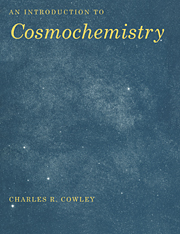Book contents
- Frontmatter
- Contents
- Foreword
- 1 Overview
- 2 Minerals: An Introduction to the Nomenclature and Chemistry
- 3 A Brief Introduction to Petrology
- 4 A Résumé of Thermodynamics and Statistical Mechanics
- 5 Condensation Sequences and the Geochemical Classification of the Elements
- 6 The Theory of the Bulk Composition of the Planets
- 7 Meteorites and the Standard Abundance Distribution (SAD)
- 8 An Introduction to Isotope Geology with an Emphasis on Meteorites
- 9 Some Concepts from Nuclear Physics
- 10 Energy Generation in Stars and Nucleosynthesis
- 11 Atomic and Molecular Spectra
- 12 The Analysis of Stellar Spectra
- 13 The Chemistry of Stars and Stellar Systems
- 14 Cold, Non-stellar Material in Galaxies
- 15 Emission-Line Regions and their Chemical Abundances
- 16 Abundances of the Elements in Galaxies
- Appendix
- References
- Index
5 - Condensation Sequences and the Geochemical Classification of the Elements
Published online by Cambridge University Press: 05 June 2012
- Frontmatter
- Contents
- Foreword
- 1 Overview
- 2 Minerals: An Introduction to the Nomenclature and Chemistry
- 3 A Brief Introduction to Petrology
- 4 A Résumé of Thermodynamics and Statistical Mechanics
- 5 Condensation Sequences and the Geochemical Classification of the Elements
- 6 The Theory of the Bulk Composition of the Planets
- 7 Meteorites and the Standard Abundance Distribution (SAD)
- 8 An Introduction to Isotope Geology with an Emphasis on Meteorites
- 9 Some Concepts from Nuclear Physics
- 10 Energy Generation in Stars and Nucleosynthesis
- 11 Atomic and Molecular Spectra
- 12 The Analysis of Stellar Spectra
- 13 The Chemistry of Stars and Stellar Systems
- 14 Cold, Non-stellar Material in Galaxies
- 15 Emission-Line Regions and their Chemical Abundances
- 16 Abundances of the Elements in Galaxies
- Appendix
- References
- Index
Summary
The Concept of Geochemical Classification
The Norwegian geochemist Victor Goldschmidt is the father of the notion of geochemical classifications of the chemical elements. Goldschmidt's (1954) posthumous work Geochemistry is still of great value. His basic aim was to divide the elements into groups which might be identified with the major divisions of the earth during its cooling history. He thought there might be three separate liquid phases, one metal, one silicate, and one primarily iron sulfide. These would be surrounded by a gaseous phase. He classified the elements from their association with, or preference for one or the other of these phases.
Let us begin with a consideration of the chemistry of meteorites and the earth. The earth may be divided into a core, a mantle and a crust. The chemistry of the core must be largely inferred, and this is essentially true for most of the mantle (Ringwood 1975, Pasteris 1984). The upper continental crust is relatively well sampled (Taylor and McLennan 1985), but it is not representative. Meteorites, on the other hand, have been repeatedly and thoroughly analyzed in the laboratory. Moreover, they are thought to be pieces of a broken-up planet, not unlike the earth (see, e.g., McSween 1987). Because of this they have been used to infer the chemistry of the earth as well as of much of the cosmos.
- Type
- Chapter
- Information
- An Introduction to Cosmochemistry , pp. 64 - 88Publisher: Cambridge University PressPrint publication year: 1995



